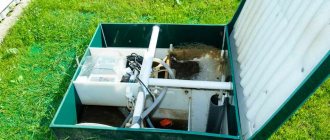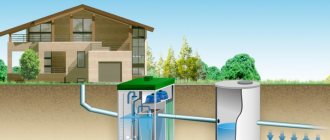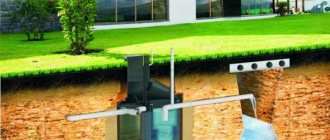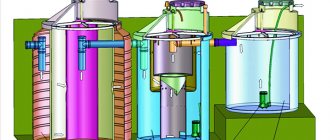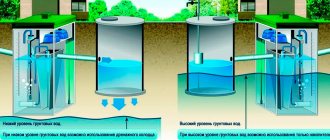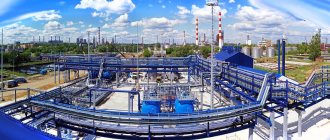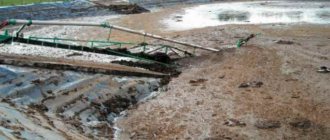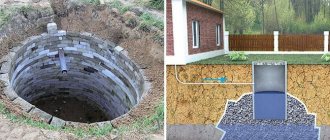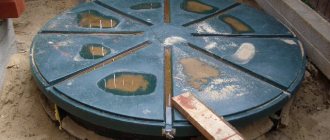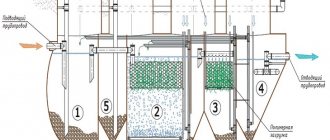Benefits of using Astra 5
- can be installed and operated in any type of soil;
- no sewerage truck required for maintenance;
- does not create unpleasant odors during operation;
- low energy consumption;
- high level of wastewater treatment.
All these advantages make Unilos Astra 5 one of the most popular wastewater treatment systems in the modern world.
The Unilos Astra 5 septic tank has only positive reviews everywhere. You can easily verify this by learning about all the advantages of a septic tank from those people who have been using it for a long time on their suburban areas.
Unilos cleaning plants
This sewer system is a modern device that purifies wastewater as efficiently as possible. Such structures are used for suburban housing construction; they are also used in more complex cleaning systems that are equipped in hotels. The main criterion for choosing a septic tank is its performance. The more wastewater a device can clean in a certain period of time, the better it is.
Septic tanks Unilos
Features of Unilos septic tanks
These structures are made of polypropylene. The operation of this treatment plant is the gravitational screening of waste. The process involves aerobic bacteria, which make the processing procedure as fast and safe as possible.
Unilos septic tanks are a structure of several containers. The number of these containers (chambers) depends on the device model. The chambers of this system accumulate wastewater and retain it for a certain time. During this period of time, heavy fragments settle to the bottom of the containers. This process is called rough cleaning. This prepares the liquid for the next stage of purification and subsequent discharge into the soil. A specialized post-treatment plant is used to discharge waste.
Purification plants of the Astra model line for private buildings are produced in four versions:
- Astra 3;
- Astra 5;
- Astra 8;
- Astra 10.
These devices are used in buildings where 3, 5, 8 or 10 people live, respectively.
Features of the Unilos Astra 5 septic tank
The lineup
- There are no mechanical elements in the design of the septic tank body. This feature makes the device more reliable.
- The body is divided into 4 chambers.
- Astra 5 is equipped with membrane aerators, which have a long service life - about 10 years. The structure operates using the intermittent aeration method. This technology allows for significant savings in resources and also guarantees the highest possible quality of wastewater treatment. Airlifts pump sludge, preserving its structure, so cleaning work is carried out continuously.
- Septic tank Unilos Astra 5 does not require additional elements to clean the liquid, since airlifts ensure the removal of excess sludge.
- The operation of a septic tank requires the installation of a filter field, which will ensure final purification of the treated water before it enters the ground.
- This septic tank is also equipped with an automatic control system for operating intensity , which independently selects the mode depending on the amount of liquid entering the waste container. The final stage of filtration can be controlled visually. If problems arise in the operation of the structure, for example, blockage caused by too much debris entering the installation, which leads to a significant decrease in the performance of the device, immediate measures should be taken to solve the problem.
- The septic tank requires an electrical connection to operate..
Return to content
Septic tank Astra 5: operating instructions
When operating the Astra 5 septic tank, it is very important to follow some rules that will ensure its uninterrupted operation. Yes, the reviews for the Astra 5 sewage system are extremely positive, but if used incorrectly, even a biological treatment station can turn into a sump that will smell terrible and have a small volume.
It’s worth starting with what you can generally reset into Astra 5:
- kitchen drains;
- toilet paper;
- drains from the bathtub or shower;
- washing machine drains;
- a small amount of waste that is formed after washing toilets.
Under no circumstances should you reset to Astra 5:
- all compounds that cannot be biodegraded;
- construction waste, as it can lead to the formation of a plug in the installation;
- various chemicals such as antifreeze, engine oils, acids and so on;
- rotten remains of vegetables or fruits;
- pet hair;
- medicines;
- a large number of substances that contain chlorine.
If there is a power outage, you should immediately limit the amount of water you use. However, to get rid of this kind of inconvenience, you can organize backup power. The entry of a large amount of wastewater at such a time can lead to overflow of the receiving chamber, which leads to its release to the outside.
There are many more nuances that are associated with the operation of the Astra 5 septic tank, but they will be discussed below.
Connection diagram Astra 5
Connection diagram Astra 5
Astra 5 can be connected to a pipeline that lies at a depth of no more than 60 centimeters. However, there are modifications that can significantly increase this depth.
You need to cut into the septic tank at a certain level. A suitable pipe should be placed above the level of the transition to the second chamber of the septic tank, since only in this case will it be possible to avoid leakage of wastewater to the outside.
Disposal of treated wastewater can be carried out in two ways: with gravity discharge and forced. The gravity-flow option is considered only if the drainage is carried out into a resorption well or ravine. In all other cases, a forced method of wastewater disposal is used. Stations that operate using the forced method are additionally equipped with a drainage well.
Septic tank Unilos Astra 5 with forced drainage
Unilos Astra 5 with forced removal
The cost is not much different from the basic configuration, but you do not have to build a resorption pit or ravine. This saves both time and effort. Many suppliers of sewerage equipment provide in advance the presence and use of a pump for pumping out wastewater. It is worth considering the fact that for high-quality pumping you will still have to equip a drainage well, where all liquid waste will flow after cleaning.
Instructions
Installation of aerobic septic tank UNILOS Astra
Anyone who has decided to independently install an autonomous sewage system for a country house can familiarize themselves with the following instructions and recommendations for installation and operation. In addition, we recommend that you refer to the regulatory construction documents - SNiPs. Modern aeration-type septic tanks or LOS (local treatment facilities) - biological treatment stations Unilos Astra and others, are made at a fairly high technological level, but are still quite simple to install and connect. An aeration septic tank is not only an alternative to a cesspool, but also a solution to the sewerage issue in general. Septic tanks do not have electronic components or complex control panels. If desired and have free time, any person who knows how to work with hand tools can install a septic tank in their dacha with their own hands.
Installation of the Unilos Astra septic tank can be carried out at any time of the year. The only requirement is that the air temperature be above -15 °C. It should be remembered that it is better to inspect the area where the work will be carried out when there is no snow cover on the ground. Installation of a septic tank at a dacha or country house is carried out in 1 day. In cases of emergency, this period may be extended. The station is supplied in a single case and assembled.
Preparing the pit and inserting pipes.
The pit is dug to a depth of:
- Unilos Astra Standard: 2.3 m;
- Unilos Astra Midi: 2.45 m;
- Unilos Astra Long: 2.95 m.
It is better to excavate soil manually. This will ensure compliance with the recommendations for the dimensions of the pit. An exception may be cases when the site has a high groundwater level or quicksand. In some cases, it is recommended to install formwork. The Unilos Astra septic tank is installed strictly level on a bed of compacted sand. The thickness of the substrate is 15 cm. The tilting of the treatment plant is not allowed. Along the perimeter, the distance from the septic tank body should be 25 cm on each side. The gap is filled with clean alluvial sand. At the same time, the septic tank is filled with water. The use of frozen sand or containing foreign inclusions, stones, crushed stone, etc. is prohibited. Sprinkling is carried out to the level of sewer pipe insertion. Technological holes for drain input and output are cut out independently. As a rule, the diameter of the inlet and outlet pipes is 110 mm. After connecting the pipe, the joints are sealed and welded. The supply pipe is inserted into the receiving chamber (A). It can be recognized by the presence of floats and a filter for large sewage (gray pipe). The outlet pipe is inserted into chamber (B) of the secondary settling tank. The lid of the Unilos Astra septic tank must be 20 cm above the ground level. It is prohibited to install the septic tank so that the lid is below ground level.
The exhaust air must be discharged through a vent riser under the roof of the house. Combining the wastewater and sewer risers is prohibited.
An electrical cable is supplied to the Unilos Astra septic tank to connect the control unit and drainage pump (if its presence is provided by the station). To avoid damage, the wire is laid in a hose or HDPE pipe of small diameter. It is recommended to include a voltage stabilizer in the circuit. The upper part of the septic tank body must be insulated 1 m from the ground level. Sheets of expanded polystyrene or similar material are often used. After connecting the inlet and outlet pipes, the Unilos Astra septic tank is finally backfilled with sand and backfill.
Preparation of the trench and installation of supply pipes.
The supply trench is formed approximately 50 cm wide (a distance of 20 cm from the pipe to the edge of the trench on each side). The bottom is filled with clean sand, which is compacted. Pipes are laid in this trench. Since wastewater enters the treatment plant by gravity, the recommended slope is: 1-2% per 1 linear meter. Pipes are used with sockets for external sewerage. Additionally, they are subject to insulation, for example with stenoflex. Also, the pipes are filled 15-20 cm with clean sand, then with reverse soil.
Disposal of treated waste.
Gravity drainage. With gravity drainage, the outlet pipe is led to the following depth:
- Unilos Astra Standard: 0.45 m;
- Unilos Astra Midi: 0.6 m;
- Unilos Astra Long: 0.9 m.
Treated wastewater can be discharged by gravity into drainage systems, ditches, containers, and distribution wells. It is not permissible to drain water into the clay, as it serves as a water seal. If the outlet pipe is located in the open air, then it must be equipped with a heating cable.
Forced drainage. With forced drainage, the outlet pipe is brought to the following depth:
- Unilos Astra Standard: 0.15 m;
- Unilos Astra Midi: 0.3 m;
- Unilos Astra Long: 0.8 m.
The pipe from the Unilos Astra septic tank comes out of the built-in container in which the drainage pump is installed. The PVC 40 outlet pipe in the insulation is mounted with a counter-slope of 5-7 cm per 1 linear meter. This scheme ensures that water does not stagnate in winter and, as a consequence, freezes. Let's allow the drain to be discharged to an open area of ground.
It is forbidden to connect the Unilos Astra septic tank yourself. To connect electrical equipment and carry out commissioning work, invite a qualified specialist. We install septic tanks for dachas and country houses in St. Petersburg and the Leningrad region.
Installation of an anaerobic septic tank
Maintenance of Unilos Astra
Questionnaire for selecting a local treatment plant
Installation diagrams of Unilos Astra stations (do-it-yourself installation):
- Astra 3 gravity
- Astra 3 capacitive
- Astra 5 gravity
- Astra 5 capacitive
- Astra 5 midi gravity flow
- Astra 5 midi capacitive
- Astra 5 long gravity
- Astra 5 long capacitive
- Astra 8 gravity
- Astra 8 capacitive
- Astra 8 midi gravity flow
- Astra 8 midi capacitive
- Astra 8 long gravity flow
- Astra 8 long capacitive
Septic tank Unilos Astra midi
Septic tank Unilos Astra 5 midi
This station differs from the standard depth at which the supply sewer pipe is installed. In the case of midi, this depth is 90 centimeters. It is worth noting that the Astra 5 midi station also includes a storage tank for water that has been purified. Often the kit also includes a drainage pump, which is necessary to remove waste from the septic tank.
The midi station is specially created for those whose pipeline depth exceeds 60 centimeters. In this case, the standard version of Astra 5 will not work, but the midi will fit perfectly into the cleaning system.
DIY motion sensor installation
Installation of a motion sensor is considered using the example of the Astra 5 , which is quite common and frequently used. It should be noted that other security alarm sensors with a similar design are installed in a similar way.
The choice of installation location is determined in accordance with the features and operating principles of volumetric detection detectors, which are discussed on the volumetric detection detectors page.
Appearance of the Astra 5 motion sensor.
|
| Before installation, the detector must be disassembled. To do this, use a screwdriver to press the lock mentioned above and remove the top cover. |
| The motion sensor board is secured with clamps indicated by arrows. Carefully moving them apart, remove the detector board. We are left with a base (next picture), which is attached to the supporting structure. |
The following is the recommended sequence of actions for actually installing and connecting the motion sensor.
All materials on this site are protected by Russian copyright law. Reprinting and other use of site materials is possible only with agreement with the owner of the resource https://metain.narod.ru.
metain.narod.ru
Installation of Unilos Astra 5
Installation of the Unilos Astra 5 septic tank is quite simple. Everything can be done with your own hands. Of course, you can invite the appropriate specialists for this, but you should prepare in advance for the fact that you will have to pay a fairly large amount for their services. It’s worth figuring out how to install such a septic tank yourself.
The work begins with finding a place for a septic tank. There are no specific requirements. The most important thing is that the treatment plant is located no closer than five meters from the house. It is advisable that there is no high groundwater level in the place where the installation will be carried out.
There is no need to install it near access roads: a sewage disposal truck will not be needed to dispose of waste. The Astra 5 biological treatment system processes wastewater into almost clean water and sludge.
Pit
Installation of Unilos Astra 5 pit
The pit is made with a small margin. You need to leave 50 centimeters of free space on all sides. It is also worth digging in depth 15–20 centimeters below the height of the septic tank. This is necessary to level and create a stable surface for the treatment facility.
Leveling is carried out using a sand mixture. It must be compacted thoroughly. It is best to level a septic tank using a level. In this way, curvature in the installation will be avoided.
Many people ignore the process of leveling the septic tank, but this should not be done. The result may be a structure that will pour waste into the ground or it will go back through the sewer pipe. It is unacceptable.
Installation of a septic tank
The septic tank must be deployed with the receiving chamber towards the pipeline to which it will be connected.
The pipeline itself must be made straight, without any kind of bends. Only in this case will it be possible to eliminate blockages. Of course, they can occur, but this will happen much less frequently. In addition, to eliminate them you will not have to use additional labor, which leads to unnecessary costs during operation.
So, the septic tank is installed in its rightful place. What's next? Now it needs to be checked again for leaks. To do this, water is poured into the cleaning system. If everything is in order, then you can begin to fill the pit together with the septic tank with earth. This must be done as carefully as possible so as not to damage the plastic structure of the septic tank.
Thus, the installation of the Astra 5 septic tank can be considered complete. As you can see, there is nothing complicated in this process. Any person who knows how to use basic tools can easily handle the job. These installation instructions will also help.
Septic tank installation
Installation of a septic tank
According to the manufacturer’s recommendations, it is better to entrust installation work to specialists. But this will lead to large financial costs. Therefore, most users do the installation themselves. If everything is done correctly, then Astra 5 will function perfectly and for a long time.
First of all, choose a suitable location. As practice shows, the septic tank should not be located more than ten meters from the house. There is no smell from it, but the cost of laying a sewer system can be significant.
Water drainage
It is very important to consider how to dispose of purified water. To do this, you can use a drainage well (if the soil is sandy or close to it) or drain into a natural or artificial reservoir. But it is more economical to build a container from where you will take purified water for watering the plants in your garden.
Before starting work, find out the level of soil freezing. It is advisable to lay all inlet and outlet pipes below this mark. If this is difficult to do, then the pipes must be insulated.
Digging a hole for a septic tank
After determining the location, we dig a pit. Since the septic tank is small, all work can be done manually. The main thing to remember is that the pit must be wider and deeper than the required dimensions. This is necessary for arranging a cushion at the bottom and for the convenience of backfilling the septic tank with soil.
Then a sand cushion up to 20 cm thick is placed at the bottom. It must be leveled horizontally using a building level. This is required for the normal operation of Astra 5. If groundwater rises close to the surface, then a concrete screed is constructed at the bottom (it is also made in a strictly horizontal plane).
Draining the septic tank manually
Septic tank installed
Now we begin to lower the septic tank into the pit. This work can be done manually with the help of 3-4 helpers. After installing Astra 5 on the base, its horizontalness is checked.
The next step is to connect the sewerage system to the inlet pipe. The joint is carefully sealed. Then the electrical cable is connected. Its connection is made according to the diagram. A pipe is also connected to the outlet pipe. It will drain the treated wastewater to a container or well.
Filling up the pit
The next step will be backfilling the pit with soil. This is done gradually, with a thickness of each layer of no more than 20 cm. At the same time, at the same speed, the septic tank is filled with water. Each layer of soil must be compacted.
When filling the top layer, it is necessary to provide a service hatch. It is located above the electrical cable connection point. This completes the installation process of the Astra 5 septic tank. The equipment is ready for use.
Maintenance of septic tank Unilos Astra 5
Septic tank Unilos Astra 5 is an autonomous wastewater treatment system. You don’t need any special skills to know the basics of operation in order to use a septic tank, but you should always keep in mind the basic rules for its maintenance. For the flawless operation of the Unilos Astra 5 sewer system, you must do the following:
- carry out visual inspection of purified water approximately once a week;
- once a month do the following with it:
- cleaning blower filters;
- removing sludge from the settling tank with a pump;
- cleaning the filter for large contaminants;
- cleaning the walls of the secondary settling tank;
- Once every six months you should do the following:
- removing the entire mass of sludge from the settling tank using a drainage pump;
- cleaning the hair trap;
- Once every two years, the Unilos Astra 5 wastewater treatment system requires replacement of compressor membranes. This should only be done when necessary or in case of breakdown. Many companies include devices and service for a certain period in the price, which is why the price for a Unilos Astra septic tank may vary.
Scheme and principle of operation of the Unilos Astra station
Home > Information > Scheme and principle of operation of the Unilos Astra station
Scheme of operation of the Unilos Astra station
Unilos Astra stations are an underground polypropylene monoblock (serving from 1 to 300 users). Inside, the stations are divided by partitions into 4 chambers:
A - Receiving chamber; B - Aerotank; B - Secondary settling tank; G - Sludge stabilizer; 1 - main pump; 2 - pump-circulator; 3 — recirculator pump; 4 - grease trap (for collecting biofilm from surface B and submitting it for processing to B); 5 - filter for large fractions; 6 - standard pump with plug (used for pumping out excess sludge “manually”)
Receiving chamber (compartment A, see diagram) - wastewater from sewage facilities (house, bathhouse, etc.) enters this compartment; large fractions are crushed here and the initial wastewater treatment occurs. Then the wastewater is fed in portions for post-treatment through the main pump (1, see diagram) into the aeration tank. The main pump is part of the large sewage filter (5, see diagram).
Aerotank (compartment B) is an artificial structure in the form of a flow-through tank for the biological treatment of wastewater from organic contaminants by oxidizing them by microorganisms located in the aerated layer. This is where the main water purification takes place. It consists of a container with an aerator in which aeration of the mixture of wastewater and activated sludge occurs, a recirculator pump (2), and a recirculator pump (3). The aeration tank is connected through the bottom to a secondary settling tank. Secondary settling tank (compartment B, shaped like a truncated inverted pyramid).
The mixture of water and sludge enters the secondary settling tank through a stabilizer using a circulator pump (2) . Here the separation of purified water and sludge occurs, the heavier sludge settles to the bottom, the purified water remains on the surface and is discharged from the station through the outlet pipe, the settled sludge flows through the bottom back into the aeration tank.
The circulator pump (airlift), when operating in the direct phase, supplies an oxygenated mixture of sludge from the aeration tank to the secondary settling tank through a stabilizer, which prevents mixing of the upper layer of water with the sludge. The debris and biofilm floating on the surface of the settling tank are discharged back into the aeration tank using a grease trap.
Sludge stabilizer (compartment D) - stabilized sludge accumulates here (it is the heaviest and gradually settles at the bottom), lighter parts of the sludge flow through the overflow hole into the receiving chamber to participate in the further cleaning process. The sludge will circulate until it reaches a stabilized (saturated, heavy) state. The sludge enters the sludge stabilizer from the aeration tank using a recirculator pump (3).
Operating principle of the Unilos Astra station
Domestic wastewater enters the equalization tank (receiving chamber A) , which serves to average the wastewater according to its qualitative composition and allows for a volley discharge without disturbing the operating mode of the station; in addition, the activated sludge contained in the equalization tank (community of microorganisms) interacts with organic contaminants and the primary biological treatment of wastewater begins. In the equalization tank, debris, suspended solids and similar contaminants are retained and accumulated.
From the equalization tank, aerated wastewater, passing through a mechanical filter, with the help of an airlift (mamut pump) enters the aeration tank, in which intensive biological treatment occurs using activated sludge. The aeration tank operates in two modes: nitrification (wastewater is intensively mixed and saturated with air oxygen) and denitrification (air supply and mixing are stopped), which allows for deep biological treatment, reducing the concentration of nitrates and nitrites.
After the aeration tank, the mixture of purified water and activated sludge enters the secondary settling tank through a stabilizer using a circular pump. In the secondary settling tank, water and sludge are separated, activated sludge settles to the bottom and returns to the aeration tank through an opening in the lower part, and purified water enters the station’s outlet line. To remove any possible grease film floating on the surface of the secondary settling tank, a grease trap is provided back into the aeration tank for further processing.
If wastewater does not enter the station, the station continues to operate in an autonomous mode of constant water circulation. A water level sensor is installed in the equalization tank. At the moment when the airlift pumps water into the aeration tank to the lower level, the sensor sends a signal to the control unit and to the solenoid valve. The valve is activated and directs the air flow into the reverse phase circuit.
When air is supplied in a different phase, aeration in the aeration tank is turned off, mixing stops, and all activated sludge settles to the bottom - the denitrification process begins. At a certain distance from the bottom, the recirculation airlift begins to pump out excess sludge from the bottom from the aeration tank into the activated sludge stabilizer.
When a mixture of activated sludge and water enters the stabilizer, the heavier part of the sludge is deposited in the stabilizer, and the light part of the sludge, together with water, is returned to the equalization tank. The water level in the equalization tank begins to rise to the level where the sensor is triggered and the station is transferred to the direct phase.
The valve then switches the air flow to the direct phase distributor. Aeration (nitrification process) begins in the aeration tank, and the recirculation airlift stops pumping out activated sludge.
In switching mode, the station will operate until wastewater arrives. The operation of the treatment station is automated and does not require daily maintenance. During quarterly maintenance, it is necessary to remove excess activated sludge using a standard air lift pump (included in the stations). If an external drainage pump is used, sludge is removed once every 6 months.
The excess activated sludge and sediment generated in the station's settling tank during the operation of the station can be used on the territory of individual households or farms for composting and subsequent application to the soil as fertilizer.
Excess activated sludge and sludge formed in a high-capacity station is delivered according to a unitary scheme to solid waste landfills.
See also:
» Cost of treatment facilities Unilos Astra
» The cost of installation work for Unilos Astra treatment facilities
» Unilos Astra service cost
» Distinctive features of Unilos Astra stations
* The prices indicated on the website are for reference only and do not constitute a public offer . You can check the cost of equipment and its availability by calling (812) 309-23-57. You can also send your request by fax (812) 309-23-58 or by email. Our specialists will contact you shortly.
Unilos Astra 5 in winter
Unilos Astra 5 in winter
As for the pipeline, it must also be insulated. Mineral wool is also suitable for this. The pipe lies at a depth of 60 centimeters, which means the ground may well freeze. The insulation will protect the pipeline from the harmful effects of frost. Frozen condensation will not form inside.

